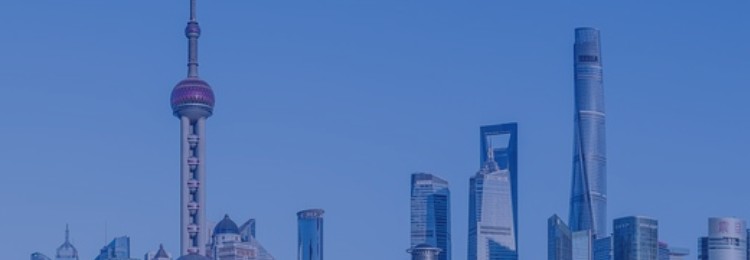"A Study on the Spatial-temporal Patterns of Exhibition Projects in Beijing-Tianjin-Hebei" was published in China Conference &Exhibition on April 15, 2022 (Issue 07, Total Issue 511). The first author He Huiwen is a researcher at the Shanghai MICEE Institute, professor and doctoral supervisor at the School of Journalism and Communications of Shanghai University; the second author Zhang Min is the executive dean of the Shanghai MICEE Institute, professor and doctoral supervisor at the School of Journalism and Communications of Shanghai University.
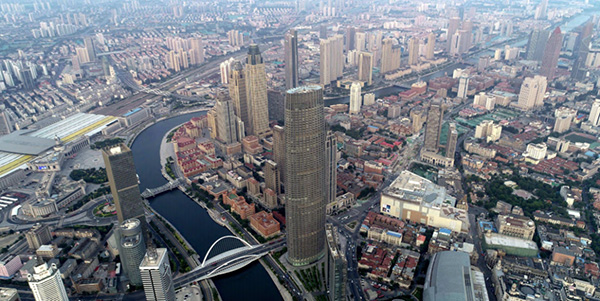
Two major recent developments in the exhibition industry, namely the upgrading of Beijing-Tianjin-Hebei coordinated development to a national strategy, and the official opening of the National Convention and Exhibition Center (Tianjin), have provided a rare opportunity for the high-quality development of the Beijing-Tianjin-Hebei exhibition industry. In order to help Beijing-Tianjin-Hebei better seize external opportunities, this article uses data crawling and business analysis methods to analyze the spatial-temporal patterns of exhibition projects in Beijing-Tianjin-Hebei, and attempts to put forward optimization suggestions: Encourage multi-point growth towards diversified development, focus on cultivating manufacturing-themed exhibitions, promote spatial sharing and vertical cooperation of exhibition venues, form a seasonal pattern of prospering in spring and autumn and steady in summer and winter, and pay attention to the life cycle of newly hosted exhibitions.
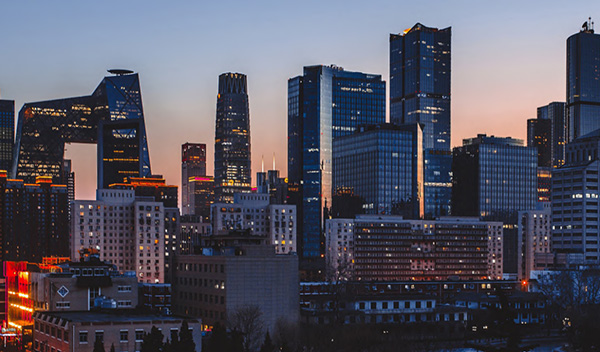
Collection and Organization of Exhibition Information
Use a self-written Python crawler to capture target information from Eshow365.com, including exhibition projects held in Beijing-Tianjin-Hebei from 2011 to 2019, mainly containing information such as exhibition name, date, venue, industry, city, and exhibition area.
The following specific analysis will focus on the research objectives.
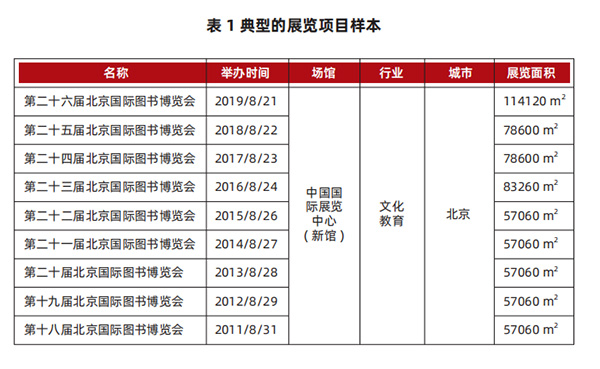
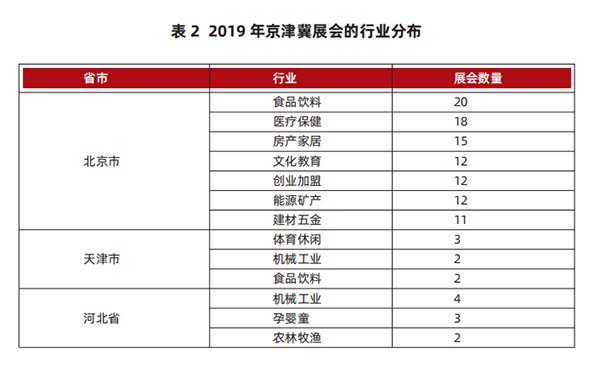
Spatial Layout of Beijing-Tianjin-Hebei Exhibition Projects
The data shows that in 2019, there were a total of 269 exhibition projects in Beijing-Tianjin-Hebei. Among them, Beijing had 229, far more than Tianjin's 16 and Hebei's 24. Among the exhibition cities in Hebei Province, Langfang stood out with 14 exhibitions, while Shijiazhuang had only 4, Xingtai had 3, Cangzhou had 1, and Tangshan had 1.
Beijing's industries with the most exhibitions were food and beverages, medical care and real estate, mostly B2C exhibitions for ordinary consumers. Among B2B exhibitions, the industries with the most projects were energy minerals and building materials hardware.
Although no particular industry stood out in Tianjin's exhibitions, B2C exhibitions for ordinary consumers still dominated overall, such as the 101st National Sugar and Liquor Commodity Fairwith an exhibition area of 210,000 square meters, the Bihai Fishing Expo with 120,000 square meters, and the North China International Bicycle & Electric Vehicle Exhibition with 100,000 square meters.
The industry distribution of Hebei's exhibitions was relatively balanced, including industrial machinery B2B exhibitions, baby and child B2C exhibitions, and agriculture, forestry, animal husbandry and fishery exhibitions catering to the demands of an agricultural province. In terms of exhibition area, Hebei's largest exhibition was the 16th Hebei International Equipment Manufacturing Expo with 50,000 square meters, followed by the 12th China North (Pingxiang) International Bicycles,Baby Strollers and Toys Fair with 40,000 square meters.
In summary, in terms of industry, Beijing-Tianjin-Hebei exhibitions had more B2C exhibitions for ordinary consumers, and a relatively low proportion of B2B exhibitions for professional audiences.
In terms of exhibition venues, 34.9% of Beijing-Tianjin-Hebei's exhibitions were held at the China International Exhibition Center (Jing'anzhuang), and 28.4% at the Beijing National Convention Center, accounting for 63.3% of all exhibitions. In related research on measuring the regional agglomeration of China's exhibition industry (Yang Xin and Jin Limei; 2014), the indicator of information entropy was used. The calculation formula for information entropy is as follows:

Where info is information entropy. The larger the value, the more dispersed; the smaller the value, the more concentrated. xi is the proportion of exhibitions at venue i to all exhibitions.
As shown in Table 3, the information entropy (info) of Beijing-Tianjin-Hebei's exhibition projects was 1.715, greater than 1, indicating that the distribution of exhibition projects across Beijing-Tianjin-Hebei venues was relatively dispersed and imbalanced.
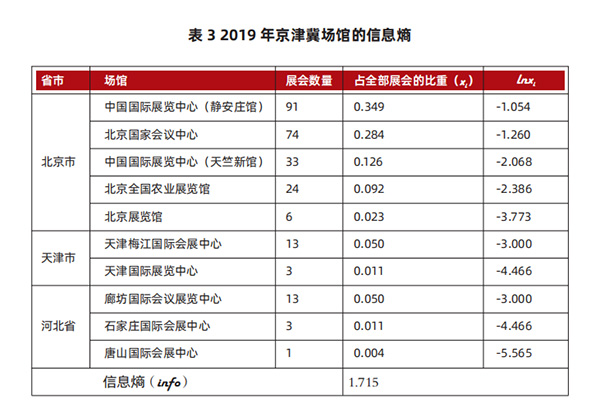
Seasonal Patterns of Beijing-Tianjin-Hebei Exhibition Projects
Table 4 lists the distribution of Beijing-Tianjin-Hebei's exhibition projects in each month of 2019, and their seasonal intensity indices. The seasonal index is calculated using formula (2):

In the formula, Xi is the proportion of exhibitions in each month to annual exhibitions (e.g. if a month accounts for 14.3% of the year, then Xi is 14.3), and 8.33 is 1/12. The closer R is to zero, the more evenly exhibitions are distributed throughout the seasons. The larger R is, the greater the fluctuations over time, and the greater the difference between peak and off seasons.
Beijing's seasonal intensity index (R) in 2019 was 4.114, the lowest among the three cities and provinces, meaning the distribution of exhibitions across months was relatively balanced. Tianjin's seasonal intensity index (R) in 2019 was as high as 10.312, indicating significant seasonality in the distribution of exhibitions, specifically with the vast majority of exhibitions concentrated in March.
Comparing the seasonal intensity indices in 2019 of other provinces and cities outside Beijing-Tianjin-Hebei (specific data omitted here), it was found that provinces and cities with R values greater than 10 included Qinghai, Ningxia, Guangxi, Shanxi, Inner Mongolia, Gansu, Guizhou, Hainan, Jiangxi and Jilin, mostly underdeveloped economies or climates unsuitable for year-round exhibitions. Provinces and cities with R values less than 5 included Shanghai, Guangdong, Beijing, Shandong and Zhejiang. It can be seen that the more developed the exhibition economy of a province, the smaller the seasonal fluctuations in its exhibitions.
The data shows that from 2011 to 2019, a total of 974 exhibitions were held in Beijing-Tianjin-Hebei. Of these, 350 exhibitions ended their life journey after the first session, accounting for 36% of all exhibitions. Of the 608 exhibitions that made it to the second session, 131 exited after the second session, accounting for 22% at the time. Of the 465 exhibitions that made it to the third session, 80 exited after the third session, accounting for 17% at the time. Once past the first 3 sessions, the exhibition mortality rate stabilized at around 10%. It can be seen that Beijing-Tianjin-Hebei exhibitions had very high mortality rates in the first three years, with nearly 60% of exhibitions closing down during the first three sessions.
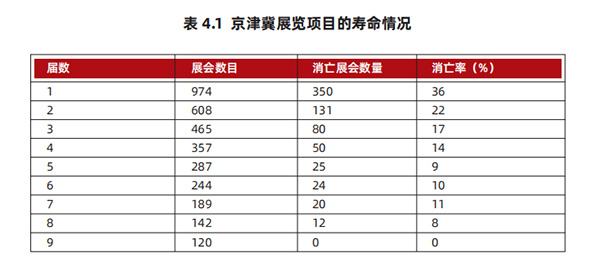
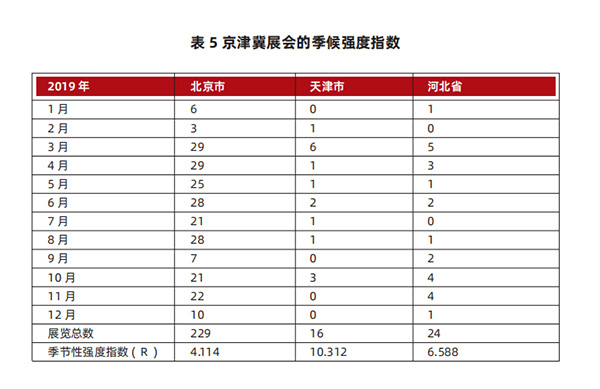
Preliminary Conclusions and Recommendations
As China's economy transitions from high-speed growth to high-quality development, China's exhibition industry will also shift from an "expansion in scale and quantity" growth model to a "structural upgrading" development model. The Beijing-Tianjin-Hebei exhibition industry, with double strategic opportunities externally, may have some deficiencies in the spatial-temporal layout of exhibition projects that need to be optimised in concerted efforts.
First, at the inter-city collaborative level, efforts should be made on the basis of the current multi-point growth model to create growth poles led by Beijing, Tianjin and Langfang as the first echelon, and growth poles such as Shijiazhuang, Xiongan, Xingtai and Tangshan as the second echelon, forming a new exhibition economic landscape featuring symbiosis and win-win between multiple poles.
Secondly, the current consumption exhibition-dominated pattern does not match Beijing-Tianjin-Hebei's manufacturing strengths. In particular, Tianjin, as the center of advanced manufacturing in northern China, should make the cultivation and introduction of manufacturing exhibitions a focus for future development.
Thirdly, in terms of venue operations, communication and sharing of information between venues needs to be promoted to advance inter-venue spatial sharing and vertical cooperation, with the aim of changing the current imbalance in venue utilization.
Fourthly, give full play to Beijing-Tianjin-Hebei's distinct four seasons, each with its own character, to build concepts of "summer with seaside beaches and summer resorts, autumn with grasslands for horse riding and fruit picking, and winter with skiing, skating and winter sports", optimizing the current spring-dominated pattern into a new pattern of "prospering in spring and autumn and steady in summer and winter".
Finally, pay special attention to and support exhibitions that have been held for no more than three sessions, lowering mortality rates for new exhibitions and providing more room for innovation, entrepreneurship and creativity.

